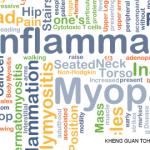Consider the diagnosis of clinically amyopathic dermatomyositis in patients who have had at least six months of skin rashes, such as a heliotrope rash, without obvious weakness, said Dr. Reed. Of these patients, about 25% will progress to juvenile dermatomyositis.1
The presence of myositis-specific antibodies can help clinicians screen for and predict specific manifestations of particular myositis phenotypes that may occur over time in patients’ lives. Examples:
- Antibodies to nuclear matrix protein-2 (NXP2) correlate with calcinosis, contractures and significant skin involvement.
- Antibodies to transcriptional intermediary factor-1γ (TIF-1γ) often predict severe cutaneous involvement, generalized lipodystrophy, photoerythema and psoriasiform lesions.
- Antibodies to TIF-1γ in adults are associated with malignancy, but this association is not seen in children.
- Antibodies to melanoma differentiation-associated gene 5 (MDA5) are associated with amyopathic disease, ulcerations of the skin and interstitial lung disease, which can be rapidly progressive.
Whenever possible, rheumatologists should seek to identify which myositis-specific antibodies are present in their patient and use this information to be proactive in delivering care to these patients, said Dr. Reed.
Treatment
No treatments have been approved by the U.S. Food & Drug Administration (FDA) for JDM. Many empiric treatments, which are based on expert recommendations and consensus treatment protocols, have significant side effects. But Dr. Kim said a few trials do exist on which to base treatment recommendations.
In a retrospective study of 60 patients with JDM who had received at least three months of treatment with a tumor necrosis factor (TNF) α inhibitor (i.e., infliximab or adalimumab), patients experienced improvements from baseline with respect to skin disease as measured by the modified skin disease activity score, physician’s global disease assessment and muscle disease as measured by the Childhood Myositis Assessment Scale (CMAS) and Manual Muscle Testing (MMT8).6
In a different retrospective study of 56 patients with JDM who received treatment with cyclophosphamide using the EuroLupus dosing protocol, patients experienced reductions in skin disease, global disease and muscle disease at months 6, 12 and 24, compared with their condition at the start of treatment.7
Finally, Dr. Kim presented intriguing evidence that Janus kinase inhibitors (jakinibs) may effectively treat JDM by blocking the interferon signaling pathway.
With respect to medications, corticosteroids are recognized as an essential component of treatment for patients with JDM. Yet no widespread consensus exists on the exact dose and duration of corticosteroids to use in these patients. Similarly, questions remain as to which immunosuppressive agents, such as methotrexate, mycophenolate mofetil or rituximab, should be employed, as well as the sequence in which to try such therapies.


